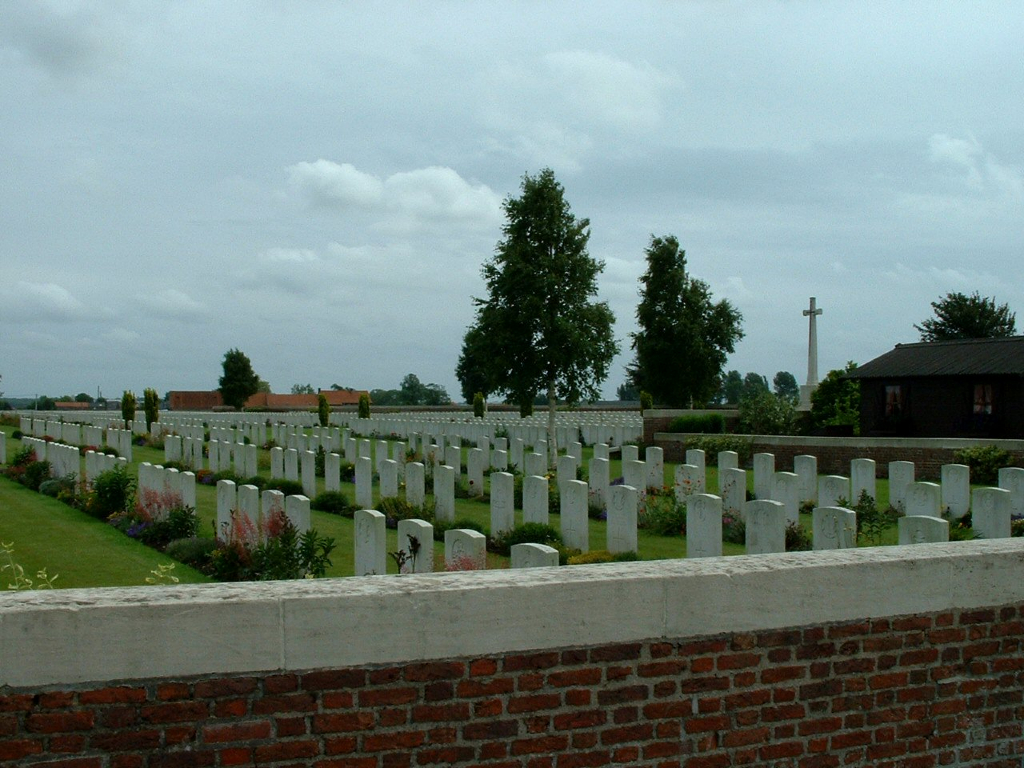Mendinghem Military Cemetery
- Country Belgium
- Total identified casualties 2436 Find these casualties
- Region West-Vlaanderen
- Identified casualties from First World War
- GPS Coordinates Latitude: 50.89751, Longitude: 2.64207
Please note
As the access path leading up to the cemetery is being renewed, access to the cemetery is only possible via the field adjacent to the cemetery.
Location information
Mendinghem Military Cemetery is located 17 Kms north-west of Ieper town centre on the N308 connecting Ieper to Poperinge and on to Oost-Cappel. From Ieper town centre the Poperingseweg (N308), is reached via Elverdingsestraat then directly over two small roundabouts in the J. Capronstraat. The Poperingseweg is a continuation of the J. Capronstraat and begins after a prominent railway level crossing. On reaching the ring road of Poperinge R33 Europalaan, the left hand clockwise route circles the town of Poperinge and rejoins the N308 towards Oost-Cappel. 6.5 Kms after joining the N308 lies the village of Proven. The cemetery is located 500 metres beyond the village of Proven on the left hand side of the road (which at this point is called Roesbruggestraat).
Visiting information
ARRIVAL
The route to the cemetery is signposted. There are Cemetery direction signs at the access track, located off Roesbruggestraat, adjacent to a red brick house.
PARKING
It is possible to park along the front of the cemetery, at the side of a track, within 10 metres of the main entrance of the cemetery. There is space for approximately 3 vehicles.
The ground is firm and level, the track surface is concrete and gravel between the wall and track. The entrance is approximately 175 metres from the main road.
ACCESS, LAYOUT AND MAIN ENTRANCE
The main entrance is a brick memorial shelter with a waist black metal gate. The gate is approximately 900 mm wide and opens inwards into the cemetery, with a lever latched handle on the left side of the gate. The ground surface in the memorial shelter is paved, flat and level. Loose gravel surrounds the outside paved part of the entrance.
There is step-free access through the entrance into the cemetery. From the main gate the Cross of Sacrifice is on the right-hand side of the cemetery, with the Stone of Remembrance opposite the Cross on the left-hand side of the cemetery. The Stone of Remembrance is on a raised platform accessed by steps in front of the Stone of Remembrance. There are multiple levels of the platform, each approximately 150 mm high. The sides of the platform are approximately 300 mm above grass level.
There are stone bench seating areas within the cemetery, on either side of the Stone of Remembrance in two small, paved alcove areas, and inside the memorial shelter at the main entrance.
The Register Box is inside the memorial shelter at the main entrance.
ALTERNATIVE ACCESS
There is an alternative entrance at the opposite end of the wall along the front of the cemetery off the access track. A 2-metre-wide double black metal, mid-level gate open outwards towards the track. There is loose gravel between the track and the gate, and a single strip of paving under the gate with grass on the inside of the gate.
The internal paths are grass and flat and firm.
ADDITIONAL INFORMATION
The cemetery is permanently open.
History information
Mendinghem, like Dozinghem and Bandaghem, were the popular names given by the troops to groups of casualty clearing stations posted to this area during the First World War.
In July 1916, the 46th (1st/1st Wessex) Casualty Clearing Station was opened at Proven and this site was chosen for its cemetery. The first burials took place in August 1916. In July 1917, four further clearing stations arrived at Proven in readiness for the forthcoming Allied offensive on this front and three of them, the 46th, 12th and 64th, stayed until 1918. From May to July 1918, while the German offensive was at its height, field ambulances were posted at Proven. The cemetery was closed (except for one later burial) in September 1918.
There are now 2,391 Commonwealth burials of the First World War in this cemetery and 52 German war graves.
The cemetery was designed by Sir Reginald Blomfield.



